Free shipping for all orders over 35 euro!
-
Shop
- Insights
-
About ROMBO
- Dealers
- Guitar Pick finder
- Gift Card
+Categories
- accessories
- bass
- bass pick
- bass picks
- bass plectrum
- bass plectrums
- beginner
- bright tone
- chose guitar pick
- chose guitar picks
- chose plectrum
- chose plectrums
- CrystalBright
- Diamond
- Diamond pick
- discipline and guitar
- DIY generation
- durability pick
- durable pick
- eco
- ecoblack
- find guitar pick
- find plectrum
- fingers vs picks
- grip
- grip guitar pick
- guitar accessories
- guitar advantages
- guitar benefits
- guitar career
- guitar health
- guitar injury
- guitar learn
- guitar lesions
- guitar lesson
- guitar method
- guitar noise
- Guitar noise plectrum
- guitar pain
- guitar pick
- guitar pick beginner
- guitar pick bevel
- guitar pick buy
- Guitar pick diamond
- guitar pick durability
- guitar pick durable
- guitar pick eco
- guitar pick features
- guitar pick grip
- guitar pick material
- Guitar Pick Noise
- Guitar Pick online
- guitar pick recycled
- guitar pick recycled material
- guitar pick special features
- guitar pick textures
- guitar pick thickness
- guitar pick variable thickness
- guitar picks
- guitar tone
- guitar warm-up
- guitarpick
- guitarpicks
- hold a guitar pick
- hold guitar pick
- hold guitar picks
- hold pick
- hold plectrum
- hold plectrums
- how to
- how to chose your guitar picks
- jazziii
- learn guitar
- lose guitar pick
- material
- materials
- mental health and guitar
- motivation and guitar
- music
- not to lose guitar pick
- Online guitar
- online guitar pick
- online guitar pick buy
- pick
- pick durability
- pick material
- pick noise
- Picks
- picks vs. fingers
- play bass fingers
- play bass picks
- play bass with fingers
- play bass with pick
- play bass with picks
- play bass with plectrum
- play guitar faster
- plectrum
- plectrum attributes
- plectrum beginner
- plectrum bevel
- plectrum characteristics
- plectrum features
- plectrum grip
- plectrum material
- plectrum noise
- plectrum recycled
- plectrum shape
- plectrum variable thickness
- plectrums
- Plek
- pua
- recycled
- recycled guita pick material
- recycled guitar picks
- recycled picks
- recycled plectrum
- Rombo Diamond
- rombopicks
- tendonitis guitar
- the guitar pick
- tone
- variable thickness
- warm tone
- warm-up guitar

Why a guitar pick variety pack is a great choice for beginner and advanced guitar players
1- What is a Guitar Pick Variety Pack
A Guitar Pick Variety Pack is a set of at least three different guitar picks aimed to contain different shapes, sizes, materials, or thicknesses of plectrums.
There are other common names for this type of guitar pick set, like “Try out Mix,” “Guitar Pick Mix Set,” or “Guitar Pick Box.” Some variety packs are focused on specific guitar areas like a “Heavy Gauge Variety Pack,” thought to be used by advanced players or “Beginner’s Variety Pack” containing medium and thin guitar picks.

On guitar picks, qualities like thickness, shape, size, and material play a pivotal role in the guitar tone, sustain, grip, or pick noise.
Therefore, it is not only about the personal preferences of the player but also about the techniques you want to develop. Your hands do an arduous job, give them the proper tools they need.
2- Reasons why a Variety Pack is a good idea
REASON ONE - It is the fastest and cheapest way of changing your guitar tone
Think about it: The guitar, strings, amp, cable, and effects pedals are all pieces of the guitar gear that play a role in tone. Surprise: guitar picks too!
Use a rounded thick nylon pick and you’ll get mellower, darker, and thicker tones. Use a pointy medium Tortex guitar pick and your tone will be as bright as you can imagine.
It only takes two seconds and the cost of a coffee to change your pick and increase your tone spectrum. Larger tone repertoire means larger versatility.
Music is about staying dynamic, and monotony kills dynamics. Therefore, your most logical step as a guitarist is to find ways of expanding your repertoire of tones and techniques. This happens with practice and the right guitar gear.

REASON TWO - The joy of exploration
Music theory, speed exercises, precision exercises, and warm-ups all have one thing in common: They focus on improvement, repetition, and perfection.
However, performance is not everything and sometimes we should focus on the joy of exploration.
The greatest ideas happen when we achieve a “flow” state, also known as the “zone.” This applies to guitar too! So, why not relax for a day, test some new pieces of gear, spark some creativity by playing around some guitar phrases, and then see what happens without planning too much and having the pressure of achieving one specific performance milestone?
Chose 4-5 different picks, turn on the amp, and give yourself a two hours break by enjoying the music you are playing now.
PS: Don’t forget to turn off your phone!
REASON THREE - Develop specific skills
Try to perform your speed exercise with a large, worn-out, thin guitar pick. Let’s say 0.35 mm.
You will face one of these three scenarios:
- You are slower than usual.
- You are as fast as usual but your technique is bad.
- You are slower and your technique is bad.
As in every discipline, using the right tools is the key to success.
“Modern Guitars” are attributed to Spanish musician, Antonio de Torres Jurado. He was a luthier, and in the mid-1800s, he began creating the style of guitar that would rise to all modern guitars.

Imagine then how immense the number of available guitar techniques that had more than a dozen decades to be developed is. From strumming to hybrid picking, palm mute, sweep picking, or down picking, all these techniques have different requirements, and different requirements can be fulfilled with different tools.
In our article, “7 essential guitar pick techniques,” we have summarized some of the most common techniques.
REASON FOUR - Different instruments
Sure, the average guitar player owns a red Stratocaster with 09 strings and plays classic rock.
But what about the rest of us? The 7 strings shredders, the acoustic unplugged fans, the indie effect experts, the experimental music lovers, the metal-heads, the bassists using picks, and the jazz/bossa relaxed musicians out there?
We all deserve to have a choice according to our requirements.

Personally, I like to play bass with a medium pick (Rombo Prisma), and I love the warm tones of Rombo Horizon for guitar reverb phrases on my telecaster. However, when I feel like using the thickest metal distortion ever, I choose Rombo Diamond.
Different guitar pick shapes, sizes, materials, and thicknesses create a widely broad tonality and usability ranges that I need to keep my motivation up!
REASON FIVE - A fresh input kills routine!
Did you use the same guitar pick for the last 20 years? Well, it’s never too late to get a little bit of fresh air and try something new.
Even the riff you have played 1000 times will sound different and you might notice that there are some nuances on “pick feedback” that can make your sound more fun and interesting.
What is the worst that can happen? In the worst case, you will discover a guitar pick that you prefer more than your usual! Go take that risk :-)
REASON SIX - A Guitar Pick Variety Pack is a great gift
Guitar players have a lot of things going on in their heads: the next gig, one unfinished song composition they started some weeks ago, the speed rates of their last practice, and more.

A Guitar Pick Variety Pack is a great gift for beginners, intermediate, or advanced players. Guitarists love trying new gear because it is a way to spark some creativity and explore tonalities.
A variety pack is a super affordable option for a small, but elegant gift to make a guitarist smile and feel excited for the next practice day.
There are many different gift options from Rombo:

If only one of the guitar picks is chosen as the new favorite one, your friend will be thankful for life!
REASON SEVEN - Reflecting on your guitar tone and level
Even if you don’t like the picks included in the variety pack, they will have a positive effect on your playing.
You will reflect and confirm why you had chosen your current pick in the past and what the advantages of it are. You will reflect on your guitar tone and the nuances of guitar pick feedback and pick noise.
These experiences accumulate, and after years of exploration, you start having a sixth sense of “feeling” your instrument, your preferences, and music in general.
What do you do with your new picks? Well, if you don’t like them, give them to a friend that could need inspiration!
3- Who can profit from Guitar Pick Variety Packs (Spoiler: Everyone)
From the reasons above, we can take away a clear lesson: It doesn’t matter if you are a beginner or an advanced player, the advantages of trying a Guitar Pick Variety Pack are always there.
Why beginners profit from Guitar Pick Variety Packs:
- Develop new skills.
- Develop a sense of exploration and identify tone nuances.
- Understand that different techniques need different requirements.
- Understand that the guitar path is a long one and that not everything is performance.
Why intermediate and advanced players profit from guitar pick variety packs:
- Expand the spectrum of techniques.
- Discover an unexpected tonality change.
- Focus on one specific technique.
- Joy of exploration.
4- Examples of a guitar pick variety pack
One example is our own guitar pick variety pack containing:
- 1 Rombo Classic | 0.45 mm
- 1 Rombo Origami | 0.75 mm
- 1 Rombo Prisma | 0.8 mm
- 1 Rombo Crisp | 1 mm
- 1 Rombo Waves | 1.25 mm
- 1 Rombo Horizon | 1.4 mm
- 1 Rombo Diamond | 2 mm
- 1 Rombo Jade | 2.3 mm
It is not only thickness that is everything. In order to make these picks more understandable for you, we have created four metrics: Attack, Flexibility, Tone, and Techniques. Here an example:

With this information, and in combination with the description of the pick and the technical drawing, we give you a very precise picture of the qualities of our guitar picks.
We also have a specific set for beginners with the “Beginners Guitar Pick Gift Box”:
And a specific set for intermediate/advanced players.

5- Conclusion
A Variety Pack is not only an excellent gift for your musician friends, but also for yourself if you are looking to explore tones, develop specific skills, or just need fresh air and try new guitar gear.
Different qualities like shape, thickness, or material, make guitar picks very different tools for different requirements. You will learn a lot in the process of testing them and every fresh input can help keep your motivation at the highest level.
The worst case: You will discover your new favorite pick!
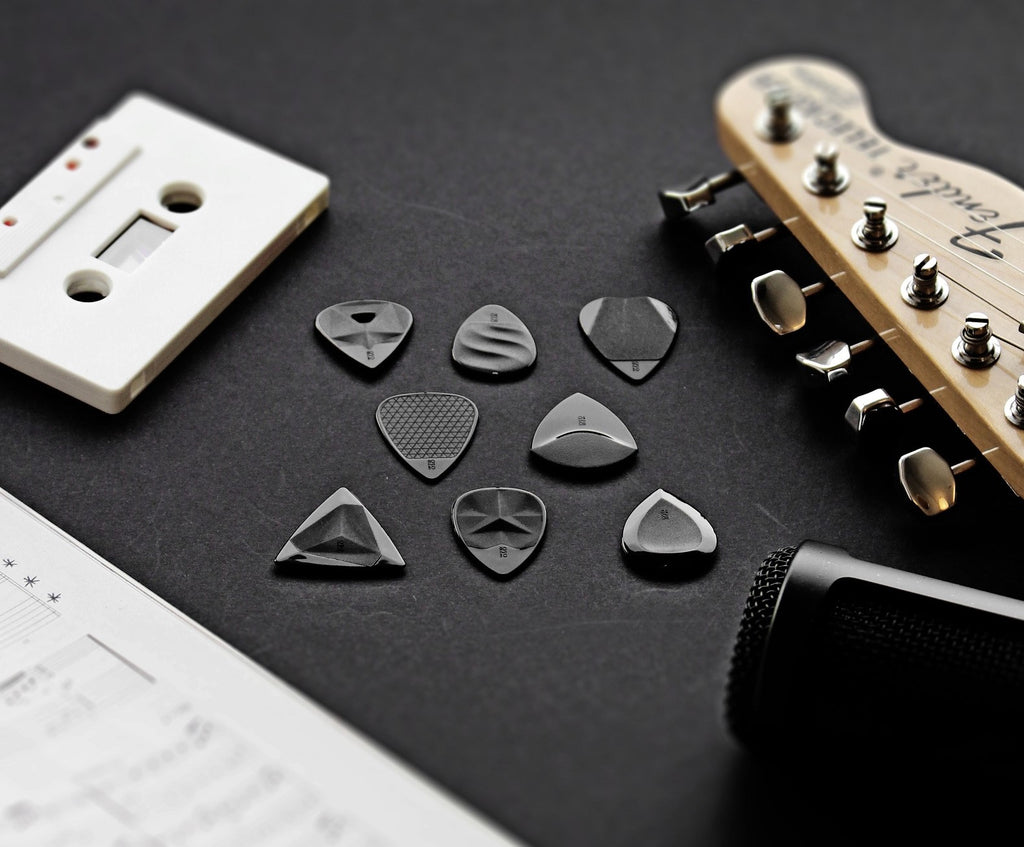

Understanding Guitar Pick Grip: Essentials
The grip of a guitar pick is one of the most controversial topics when it comes to guitars.
Different materials or shapes of guitar picks make this topic as interesting as confusing to many guitar players.
Everyone is different and everyone plays differently. However, we (guitarists) have the same goal in this area: have a decent guitar pick grip and play as comfortably as possible.

1. What is Guitar Pick Grip?
Grip is defined as “a firm strong hold”.
The grip of a guitar pick should be good enough to avoid the slipping of the pick, the turning of the pick, or (worst case!) the dropping of the pick. In addition, it should be able to give you enough flexibility and freedom to change the position of the pick when needed.
The grip is mainly caused by the material and the texture of the surface. Nevertheless, there are other aspects like overall size or 3D geometries that can substantially increase how firmly a guitar pick can be held.

2. Advantages of Guitar Picks with high Grip
Guitar picks with a high grip can help to keep your pick from slipping. These guitar picks “stick” to your fingers even when you play aggressive guitar techniques.
They are also known for providing a feeling of secure hold and control. Your hand will need less tension to hold the pick and this will help to relax your muscles.
We have already discussed how important it is to have relaxed muscles when practicing guitar in our article “7 easy warm ups every guitar player should know”.

The biggest advantage is their usage in live performances, where control and security is essential to play correctly every chord. However, they can still drop and get (instantly) lost. Therefore we suggest having a couple of extra picks with quick access somewhere on the stage or to use a Guitar Pick Holder.
3. Disadvantages of Guitar Picks with high Grip
Although guitar picks with high grip feel very secure, this feature often comes with some disadvantages. The aggressive grip surface can feel uncomfortable or even damage your skin. This is a common problem for professional guitarists training over 2 hours a day.
The high grip sticks to the fingers and this eliminates some of the freedom you have when moving your pick on purpose, for example when you change its position to execute pick slides or harmonic pinches.
4. Types of Grip Textures on Guitar Picks
Depending on the type of guitar you play, your music style and techniques, or how sweaty your hands are when you play the guitar, you will need a different type of grip texture.
These are the most common grip textures on guitar picks:

Guitar Picks with Sandpaper Grip:
Maximum grip. Very aggressive texture. Can be uncomfortable for long playing sessions.
Guitar Picks with raised Geometries or Logos:
High grip. Aggressive texture. Can feel uncomfortable for long playing sessions.
Guitar Picks with Micronodules Texture:
Medium grip. Comfortable texture and adequate for long playing sessions.
More information about this grip texture can be found here.
Grip Holes or deepened Geometries:
Medium grip. Sometimes uncomfortable when holding the pick very tight.
Homemade Guitar Pick Grip:
Some players use tape or make scratches on the pick surface to create a custom experience.
5. Less common Ways to increase Grip on Guitar Picks
As mentioned before, not only material and textures can create grip on guitar picks. There are two factors that are usually unknown and can be very helpful to increase the grip.
Using Guitar Picks with 3D Geometries on the Hold Area:
3D geometries are an underestimated way to increase grip on guitar picks. The concave and convex surfaces will create a very defined position of the guitar pick and avoid the turning of the pick without the drawbacks of aggressive textures.
In addition, correctly tilted surfaces will use your fingers as support or pivots when moving the pick on purpose.
At Rombo, we believe this is the future of guitar picks and we are increasing our efforts in this area.
One very visible example of this is Rombo Crisp.

Using a larger Guitar Pick:
The shape and size of a guitar pick are essential to increase the grip. The larger the surface, the more contact it will have with your fingers, and therefore the more friction it will create.
The best example for this are bass players that use picks. The strings of the bass are very thick and with every impact, the pick must be held very firmly. Most bass players use big sized triangle picks or teardrop picks with enough surface on the body.

Holding your Guitar Pick right:
This is an external factor and not intrinsically dependent on the guitar pick. However, I decided to include it because of the number of players having trouble with this issue and not being aware of it.

If you feel you cannot hold the guitar pick firmly and some techniques make the pick slip or drop, you should question how you hold a guitar pick before you question the grip provided by the pick.
For these people, we created an article called “How to hold a guitar pick”, which can be found here.
6. Guitar pick Grip at Rombo
The absolute guitar pick grip of our picks is determined by four factors:
- Material
- Micronodules grip textures
- 3D geometries
- Variable thickness
The combination of these factors creates a medium-high grip, which is still comfortable enough for long playing sessions and adequate for live performances.

When developing the grip, our focus was to create a type of grip which allows the player to keep enough flexibility and freedom, as well as providing a high feeling of security and control.
With the material, we made no compromises and chose a very improved version of nylon manufactured in Italy. We have discussed its properties here.
7. The adequate Guitar Pick Grip for you
It is up to you to find a balance between comfort and grip. Some players prefer non-sticky guitar picks, others need the maximum grip available.
Depending on your playing style, your hours of practice, and the environment (solo, studio, live, ...), you might need different guitar pick grips for different occasions.

Personally, I put comfort at the top of my priorities when it comes to guitar playing. Once I get used to a guitar pick, the grip is a secondary aspect to take into account. If I choose a comfortable holding I can put my attention on other aspects like tone or attack.
8. Conclusion and last Thoughts
There are many different levels of guitar pick grip depending on the material, the textures, the size, and other secondary aspects.
The greatest guitar players use different picks for different occasions or instruments, and we recommend having at least 3 favorite guitar picks to vary things like tone, attack, grip or flexibility, and become a more versatile guitar player with the ability to adapt yourself to different environments.
Choosing the right guitar pick grip is a journey every guitar player will experience. I hope you enjoy the journey and try lots of different and interesting types of guitar picks!


10 Ways to avoid sweaty Hands when playing Guitar
Sweaty palms or sweaty hands are one of the most common issues guitar players suffer from.
Playing with wet hands makes it difficult to play and some techniques like bends and slides can get a bit tricky.
Not only will your playing be affected by sweat, but also your guitar: the salts contained in the sweat will erode your strings and can even damage the neck of your guitar.

If you experience this problem often, you will know the feeling of reduced grip, imprecise movements, and lack of control when playing guitar. This can lead to frustrating moments and, in the worst case, to stop playing the guitar forever.
Nevertheless, we have two good news for you:
You are not alone: sweaty hands is a problem that affects almost 10% of guitarists.
Sweaty hands won’t prevent you from becoming an excellent guitarist. There are many solutions.
We have done our job and talked to many experts to summarize the top 10 ways to avoid sweaty hands when playing guitar.
Tip 1 - Relax and calm down:
The most common reason for sweating while playing guitar is being too nervous. Especially in live performances or during studio recording sessions.
At home, you are in a controlled environment and you can reduce the tension of your body more easily, you can take your time and start again from the beginning when making errors.

Some guitar students have reported having sweaty hands only during their guitar lessons or rehearsals.
If this is your case, take a couple of deep breaths and warm up before you play guitar. Try to learn how to control this situation and understand that it is only mental. Good luck with it!
Tip 2 - Cold Water and Soap:
In combination with the first tip, washing your hands with cold water and soap before playing guitar can work very well.
Soap removes dead skin cells and carries away oils and dirt so you will be protecting your guitar from dirt, especially your guitar strings.

Tip 3 - Play in a dry Place:
Even in the warmest months, looking for a dry place to play guitar can help a lot when it comes to sweat.

One way to reduce the humidity of the air is by using air conditioning. Other alternative ways to keep a room dry is growing plants that absorb humidity or using a dehumidifier.
Tip 4 - Use a Fan:
Using a fan that points to your guitar will help evaporate your sweat and keep your hands cooler, making them sweat less.
The biggest downside of this solution is the noise created by the fan. Especially if you are playing at home and want to relax, the noise of a fan can be annoying even when playing electric guitar.
Tip 5 - Use a Towel between the Songs:
The same way you tune your guitar between songs, you should dry your hands as well and wipe the strings down after every song and after playing.

Sweat is a guitar string killer, and some people have very acidic sweat that will damage the guitar and strings even faster.
Keep a towel on your guitar case, and after a couple of sessions you won’t even notice you are drying your hands.
Tip 6 - Baby Powder:
Baby powder, also known as talcum powder, is a great home remedy for sweaty hands when playing guitar. It’s simple, fast, and effective.
Many great guitarists have used this method over decades and even carried a small bottle of talcum powder for every gig.
Tip 7 - Climbing Chalk:
To be confident in your guitar playing, you need to be sure that your sweaty hands are perfectly taken care of and stay dry.
If the talcum powder did not work you might consider looking for professional climbing chalk.
Tip 8 - Stay hydrated:
Staying hydrated not only will help you manage your body temperature and make you sweat less, but also have a healthier sweat. What do I mean by this?

When your body is dehydrated, there will be an increase in the concentration of sodium in sweat which is indicated by a higher pH value.
Acidic sweat is very sticky and uncomfortable to play with, and it will damage your guitar and corrode your strings even faster.
Tip 9 - Use the right Finish for the Wood of your Guitar Neck:
Guitar necks are made out of many different wood types and wood finishes, for example varnished or bare wood.

Bring your guitar to a luthier and talk about the problem with your hands. He will recommend the best finish for your type of skin and playing style and you will increase the chance of finding a practical solution.
Tip 10 - Visit the Dermatologist:
Everybody’s hands sweat. If you have tested many methods to reduce sweat while playing guitar and this is taking away your enjoyment or affecting your technique, you should visit a dermatologist and check if you suffer from hyperhidrosis, a medical condition that affects 2.8% of the global population.
They work every day with such problems and will know what to do so you can play guitar again without any worries.
Bonus: Tip 11 - If your picking hand sweats, find a suitable guitar pick
Sometimes the best place to start is with a Variety Pack containing different guitar picks.

Last Thoughts:
You are not alone. Talk to other guitarists, share your solutions with them and help each other. The guitarist’s learning path is a path full of obstacles and sweaty hands is just one of them.
Talk to your guitar teacher and let him or her know about your problem. Likely, we will also have had some other students with the same problem.
Please let us know if you have found an even better method to prevent your hands from sweating when playing guitar, so we can include it in this article. Thanks!

Picks vs. Fingers for Playing Bass Guitar
You have probably heard this question many times: Should I use a pick or my fingers to play bass? You can find a huge amount of different answers on the Internet and still be confused.
My philosophy is, to never limit yourself. Both methods are valid and appropriate for the right musical context.
Picks vs. Fingers: The Eternal Debate
Whether using picks or using your fingers, each technique has its place and, ideally, you need to feel comfortable with either one you choose.
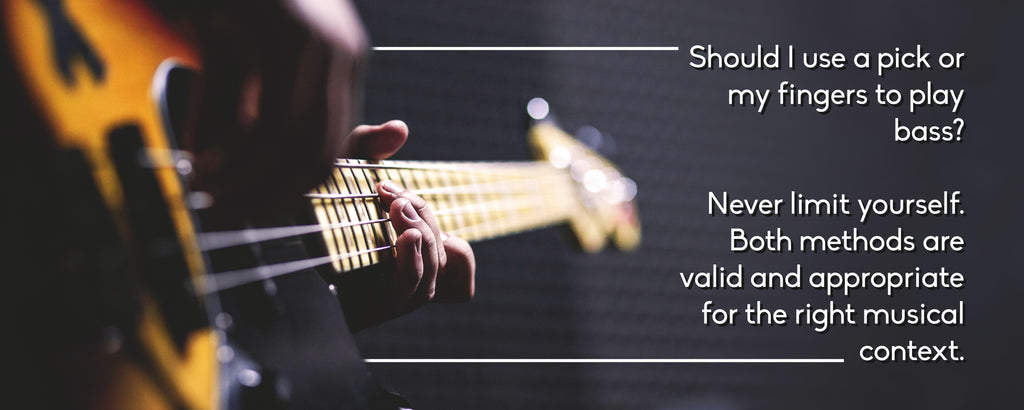
Is there a wrong way to play an instrument? Any method you use to get sound out of your instrument - fingers, pick, nails, palms of your hands, etc - can work, if the sound produced is the sound you are looking for. It is entirely a matter of personal preferences.
Therefore, this is an unimportant debate, if your plan is to be a versatile musician, and be able to understand the rich parts of every bass line, regardless of the method used to play them.
For me, it is difficult to understand how this debate has been one of the most controversial topics since the advent of modern music creation decades ago.
Why not keep an open mind and become comfortable with both methods? There is room for everything.
Using Fingers to Play Bass
Usually, bass players report having more control when using their fingers, giving them a richer tonal variety, and beefier tone. In Addition, the popular slap technique used by many bassists can be easily implemented, if you don’t hold any pick between your fingers.
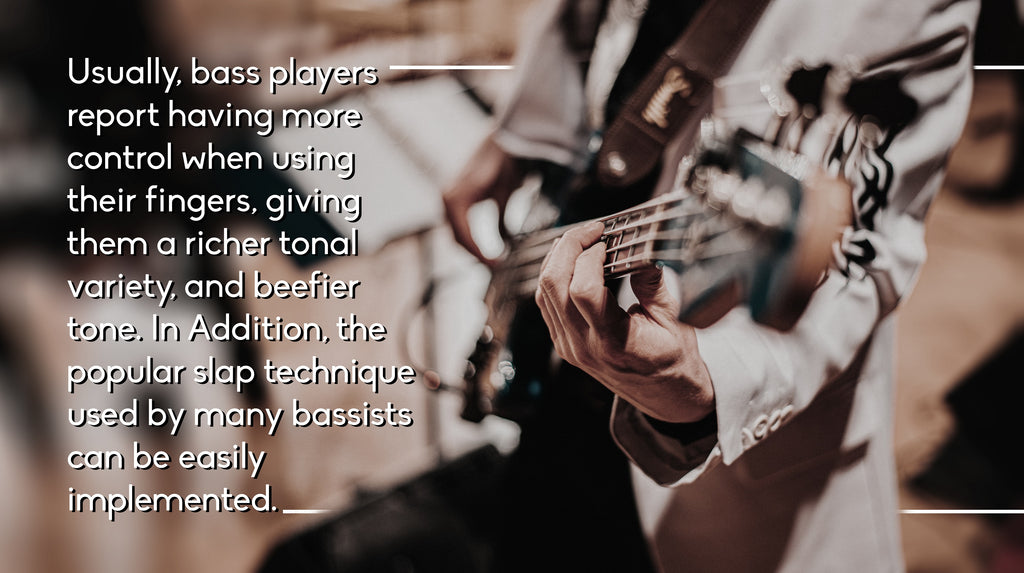
A funny positive argument is, that you will never lose your bass pick if you don’t own one.
One of the drawbacks of this method is that it takes a little more work to learn. Nevertheless, if your goal is long-term learning, this should not be a technical obstacle.
Using Picks to Play Bass
The biggest advantage of using a pick for the bass guitar is obvious: Instant speed. You can develop speed more quickly and effortlessly.
If the bass lines you want to learn, belong to certain music styles that are speed intensive, a pick might make sense. You can develop the same speed as with your fingers, but it will take much more time.
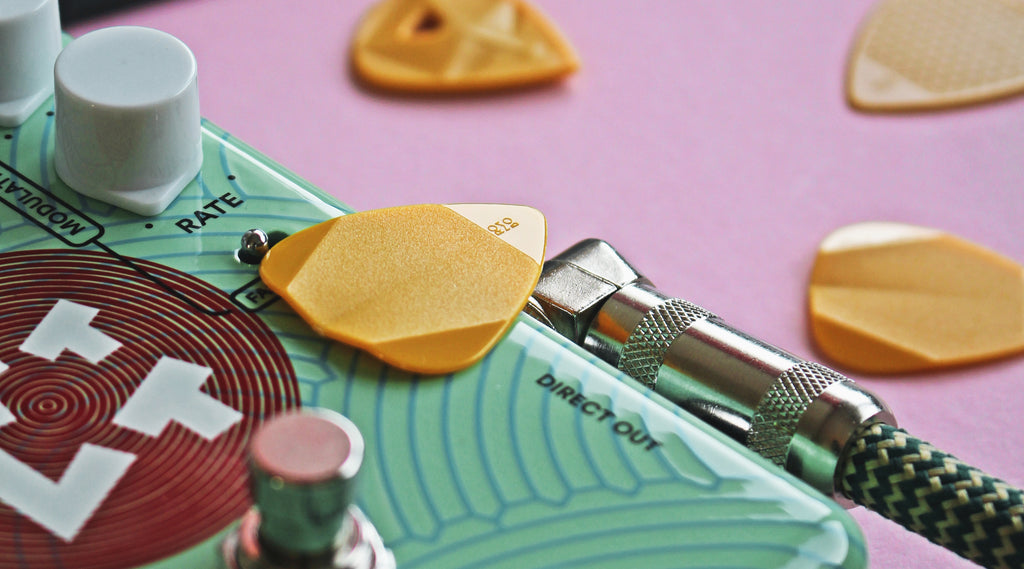
In addition, the tone can be easily changed by using a different guitar pick. This allows you to have different tones, and experiment a lot to find the right sounding bass guitar pick.
Every pick - for guitar, bass, or other instruments - has four different main parameters: Shape, material, thickness, and size. Combined together, they result in a very specific range of tone textures, attack soundwaves, and feedback. Therefore, choosing your guitar pick is one of the most difficult tasks. We have created a guide HERE, that will help you find your tone.
Pick Thickness for Bass Players
Bass players generally use thicker picks. The thickness improves the bass playing control, and the overall tone of the string.
The average pick thickness for bass players is 1.17 mm, while for guitar players is 0.89 mm. Remember, bass strings are much thicker than guitar strings. Therefore, a thinner plectrum will give you much less control in comparison to a thicker plectrum.
The size of the pick will also have a role in the creation of the tone.


Having said that, there are still many bassists who do prefer to use thinner bass picks, like for example Rombo Classic, or Rombo Origami.
If you have no idea where to start, take the average value and look for picks with a gauge of about 1.2 mm. This is a good place to get started. From there, you can go up and down and try other picks depending on your preferences. It might be a good idea to look for the bass picks your favorite players use, and try to understand why they do so.
Most Popular Pick Shapes for Bass:
The truth is, most classical shapes tend to have an excellent reception between the bass players.
The most popular shapes are the classical teadrop pick shape, the rounded teardrop pick shape, and the triangle pick shape.
In addition to shape, there are many other attributes that define a pick. HERE you can read about the 6 most underrated attributes of guitar and bass picks.
Teardrop
Teardrop is the most popular and known type of guitar and bass pick. Semi-sharp point for quick attacks, that maintain a wide range of possibilities, depending on the thickness and material used.
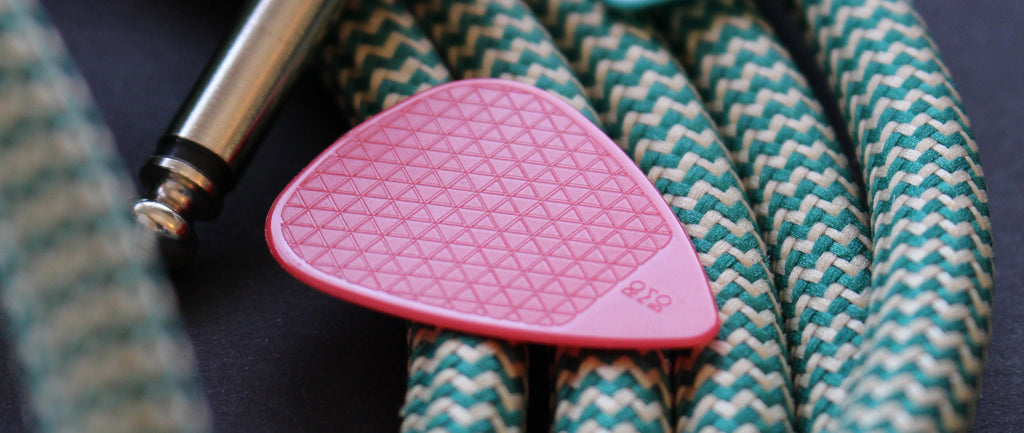
Rounded
Rounded picks provide a more warm sound and smooth attack. These are for the bass players looking for a way to play the bass strings with less force and attack. Sometimes they are totally free when a teardrop pick is completely worn down.
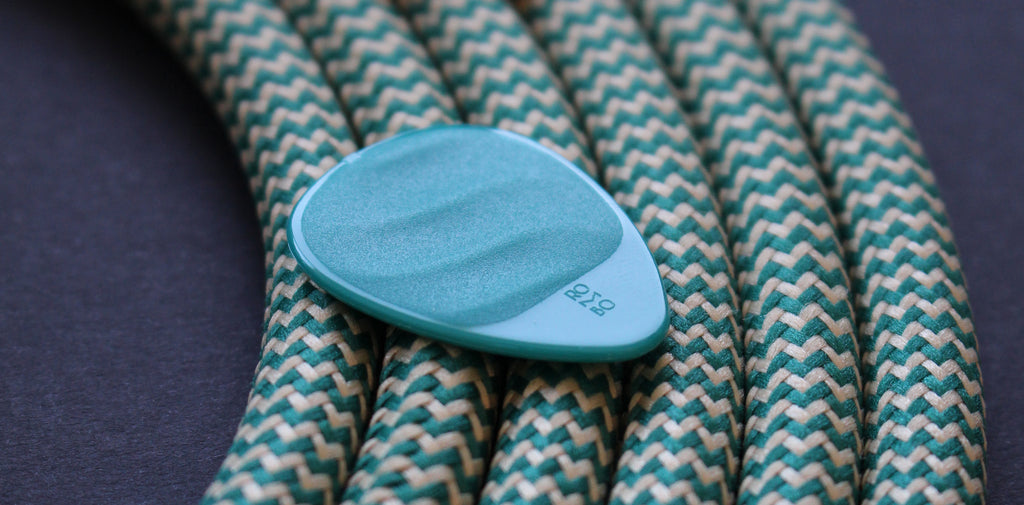
Triangle
A triangle pick is the most practical option because of the tri-sided feature. You can pluck your string with any of the three pointy tips this pick provides. A triange pick is recommended for those players who constantly break the tips of their picks.

Pick Materials for Bass Players:
When it comes to bass, we apply the same rules as with guitar picks.
After studying the physics of guitar picks, and all the material possibilities we have, we came to the following conclusions. The pick material should:
- feel nice to the touch and be comfortable, yet provide grip
- be able to create clear tones, without compromising the bass tones
- be very versatile: feel flexible when thin, and feel stiff when thick
- be durable
- look nice

You can read all about materials used at Rombo HERE.
You will also find a link with the information about Eco-Black - These picks made out of 100% recycled fibre waste, that we manufacture ourselves.
The durability of Bass Picks:
Because the strings are thicker, and bass players tend to play with more energy, the lifetime of your pick will be substantially reduced.
A way to reduce the wear and tear of picks for bass is:
- Using thicker picks
- Using harder materials
- Using picks with polished tip
- Using triangle picks (3 tips take longer to wear down).
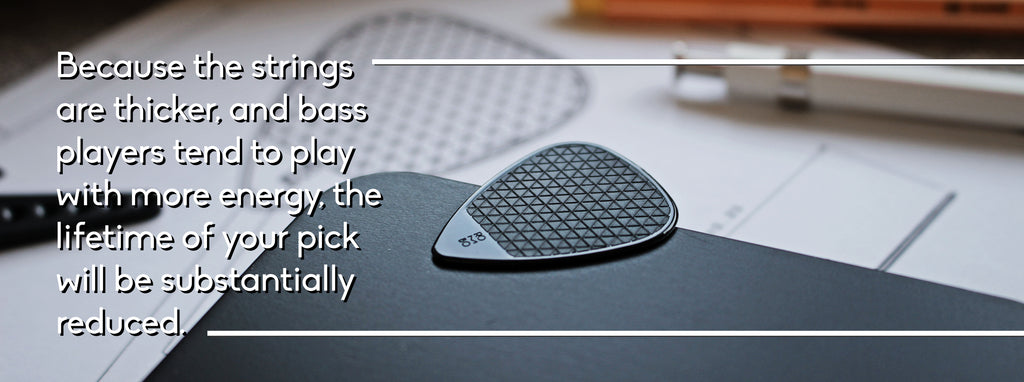
Conclusion:
Playing bass with a pick is as valid as using your fingers, if this is the tone you are looking for.
Finding a pick you are comfortable with, is a difficult task, but testing lots of them and recording some of your bass lines can help you find a balance between the tone you want, and the feel and feedback you wish from the pick.
In picks, qualities like thickness, material, shape, and size play a pivotal role in tone, feedback, grip, pick noise, sustain, etc... Music is about staying dynamic and monotony kills dynamic. Therefore, the most logical step for you is to explore enough to understand as many aspects of the bass as possible.
This applies to guitar gear in general (including picks, strings, cables, etc...) and your practice habits, style preferences, and your own psychological bias/barriers.
Sometimes the best place to start is testing a Variety Pack

- Shop
- Dealers
- Legal Notice
- Terms of Service
- Refund Policy
- Shipping
- Privacy Policy
- Contact us
- Press
- FAQ
Sign up to get the latest on sales, new releases and more…
By signing up you agree to our privacy policy.
© 2025 ROMBO.
registered brand
Powered by Shopify

